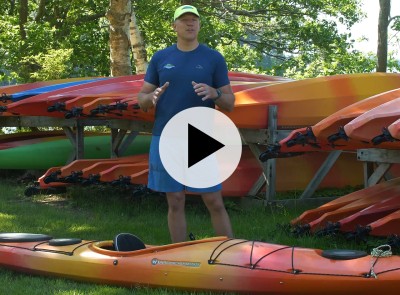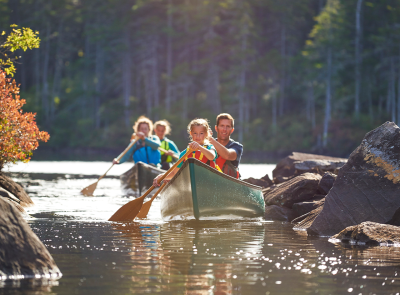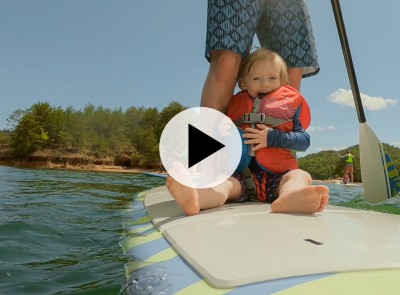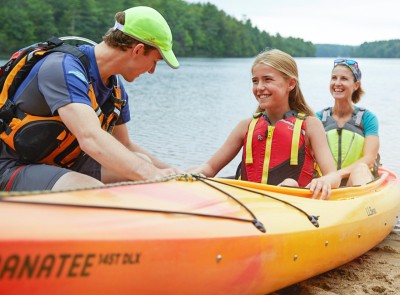(SPEECH)
[00:00:00.00] [MUSIC PLAYING]
(DESCRIPTION)
[00:00:00.00] Text, L.L. Bean. How To Stand & Paddle On A Sup, Kevin, Instructor.
(SPEECH)
[00:00:04.99] Today, we're here to talk about stand-up paddling. We're going to go over how to hold the paddle and how to do some basic strokes, like a forward and reverse sweep, a forward stroke, and how to stop.
(DESCRIPTION)
[00:00:14.32] How to Hold.
(SPEECH)
[00:00:15.28] Some paddles are one-piece paddle, two-piece, or even three-piece. Some are non-adjustable and some are adjustable. Mine is a one-piece paddle size to myself. So to figure out how to size it and where you put your hands, I put the power face of the blade, which is the canted part, in front of my toes, reach my hand up, and the base of my hand should be right at the top of the paddle. That's now the right height for me.
[00:00:39.05] The next step is to figure out where to put my hands on the paddle. I'm going to put one hand on the palm grip, nice and light grip. The other hand out here, I've got to figure out where to put it on the paddle shaft. So I'm going to place the paddle carefully on top of my head, make a nice right angle with both arms, and then bring the paddle down in front of me. Always keep a nice, light grip so you're ready to paddle.
[00:00:59.59] [MUSIC PLAYING]
(DESCRIPTION)
[00:01:00.12] He walks into the water carrying his paddle board and paddle, and wearing a life jacket. He places the paddle onto the water and attaches the leg rope above his knee.
[00:01:09.59] He lays the paddle horizontally across the board and hops onto the board on his knees. The board moves forward in the water. He lifts the paddle and rows forward several feet.
[00:01:19.61] He lays the paddle on the board and hops from his knees to his feet. He stands up and paddles forward. Text, How To Stand Up. He kneels on the board in the water.
(SPEECH)
[00:01:29.32] It's really important to know how to stand up on a stand-up paddleboard. It's also good to know that you can sit and paddle, you can kneel and paddle, you can lay down and paddle. So there's a lot of options, depending on conditions, weather, and what you want to do.
[00:01:41.23] But let me show you three different ways you can get up on a board, and then you need to choose the right one that's going to work for you. First one is I'm on my knees. I'm going to put my hands right around the paddle and put them right on the deck pad there. So now, I have four points of contact.
[00:01:57.32] And what I'm going to do is replace my feet to where my knees are. And do foot, foot, look up towards the horizon, and stand right up on the board. Another way is you can hop up. Some people find it a little bit easier to do one motion, to do a hop and then a stand from there.
[00:02:15.74] If either of those aren't working for you, there's another way. You could do foot, foot. And then if you need a little extra help, put the paddle right on the deck pad, ease your way up, keep your knees nice and bent, and look out on the horizon.
[00:02:28.85] Once we get to that standing position, it's good to know what the stance is and what our body should be like. This is what we call a neutral stance. Our feet are equal distance on either side of the belly button, more towards the edges of the board. My knees are nice and bent like an athletic stance, back's nice and straight, and you want to look out at the horizon. Then you have your knees as shock absorbers, that they'll be able to absorb some of the waves and bumps on the water.
[00:02:51.32] [MUSIC PLAYING]
(DESCRIPTION)
[00:02:52.07] An overhead view of Kevin back paddling. The board spins. He paddles forward. Text, Forward & Reverse Sweep Stroke.
(SPEECH)
[00:03:00.87] The first strokes we're going to go over today are a forward and a reverse sweep, and they're to turn the boards because they don't always go straight. Let's get into the forward sweep. First thing is you're going to bend your knees to get lower towards the board. You're going to have a low shaft angle, reaching with the power face of the blade towards the nose of the board. Unwind your core, carving a big smiley face just under the surface all the way to the back edge of the board for a long, shallow stroke.
[00:03:27.47] For a reverse sweep, we're going to use that back face of the paddle. So we're going to get low, rotate towards the tail of the board, put the back face flat for support when we start, unwind my core, carving a big smiley face under the surface to the nose of the board.
[00:03:42.97] [MUSIC PLAYING]
(DESCRIPTION)
[00:03:44.05] He paddles forward with short, quick strokes. The board moves straight over the water. Text, Forward Stroke.
(SPEECH)
[00:03:53.22] When we break down the forward stroke, the first thing I think about is my stance. Feet are on either side of the belly button of the board, knees have a nice natural bend in them, back's nice and straight. For that forward stroke, it's a vertical shaft angle, reaching out towards the nose of the board.
[00:04:08.49] I'm going to have my hands stacked, almost like it can drop an orange or a tennis ball from one to the other. I reach out with the power face of the blade towards the nose. And then it's a downward sidewards crunch with my obliques right along the edge of the board, and come out for a short stroke at my feet.
[00:04:24.17] [MUSIC PLAYING]
(DESCRIPTION)
[00:04:25.26] He uses the forward stroke for several strokes on the left side of the board, propelling the board over the water.
[00:04:40.30] He bends his knees slightly and drags the paddle over the surface of the water. The board slows down. Text, How To Stop.
(SPEECH)
[00:04:47.81] Now, we're going to learn how to stop. To stop, it's pretty much half of a reverse sweep. So the first thing we're going to do is get low by bending our knees, torso rotate towards the tail of the board, put the back face flat on the surface of the water. And then unwind our core, carving a big smile-- half of a smiley face under the surface to my feet, and recover the blade. By doing that, that'll ease us to a stop.
[00:05:13.22] What I mean by a climbing blade angle is the blade starts flat by the tail of the board and unwinds to vertical by the time I recover it at my feet. So it looks like this. Get low, rotate towards the tail, back face flat, unwind with that climbing blade angle, recover the blade, and you should be stopped.
[00:05:32.30] Today, we talked about different length paddles and how to adjust them for yourself, how to hold on to the paddle, how to get up from the board a couple different ways, your stance on the board, and a couple of basic strokes to get you moving. I hope to see you on the water soon.
[00:05:47.55] [MUSIC PLAYING]
(DESCRIPTION)
[00:05:48.45] He paddles across the water. Text, L.L. Bean. Be an Outsider.
[00:05:56.55] A group walks across the ridge of a mountain.







